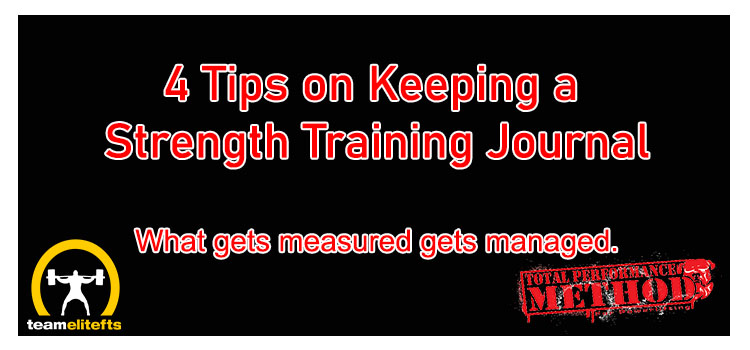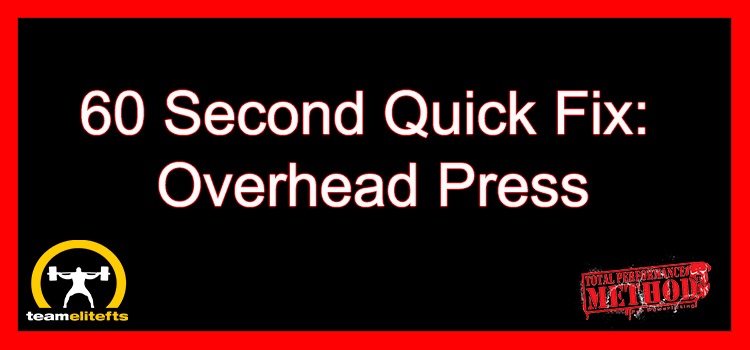
This log was originally posted in 2019 but I decided to update it a little. I'm not recycling content, I'm replacing missing content that I feel will be helpful for all of you since the site was updated. With that said, here are 4 Tips on Keeping a Strength Training Journal and why you should use them.
What gets measured gets managed was spoken to me many years ago in regards to tracking information for my business.
And I wasn’t very good at it when I first started, but learned the value quickly in knowing my numbers, and other valuable information.
Tracking data on important things allows you to measure and manage. But, If you don’t track trends, numbers and other pertinent information on the subject important to you, you’ll be spinning your wheels and going nowhere soon.
Well, I’ll bet that your training is pretty important to you. Do you keep a strength training journal?
I pretty much always did, but haven’t lately.
If you dig through my locker, you'll find journals going back to the early 90’s and yes, I look at them periodically and see what worked for me and what didn’t, what affected me and what didn’t and much more.
Once I could no longer squat or deadlift I stopped I stopped keeping a journal because I started winging it in the gym due to issues limiting me from doing most of the stuff I like to do that work.
I figured why track the fluff and buff shit I am doing?
Boy, I was wrong because my training has gone nowhere. I don’t need a journal to know that I can’t just wing it. I need a plan.
Now, many of you may train with no plan, you just pick an exercise and smash it; but I feel you probably still could keep a journal with some basic info.
Why?
Your memory lies to you sometimes. Everyone remembers that time in 1987 when the benched 595 with 2 Blue Bands for a double.
Right?
So, whether you train on a plan, make it up as you go along or have a coach, I’m going to give you 4 Tips on Keeping a Training Journal.

Strength Training Journal Tip 1:
Use a paper notebook and a pen.
You all know I hate having a phone in the gym. It is a distraction.
Use an old school notebook and a pen and later on, transfer your data to a spreadsheet or program if you want.
Keep distractions to a minimum in the gym.
Strength Training Journal Tip 2:
Track the minimum data at the least.
The minimum data is:
- Your Primary Movement for the Day
- Name of exercise
- Top weight lifted
- Number of reps
Doing this will allow you to keep track of PRs’.
Strength Training Journal Tip 3:
Keep a Chart in the Front or Back of the Book.
The chart is best kept for the major exercises. For most of you it is it the Squat, Bench and Deadlift.
If you train Strongman, add in the major events, and if you are a Weightlifter, track your Clean and Jerk, Snatch, Power Snatch, Push Press and whatever other MAJOR lifts you do.
Let’s stick with the Squat, Bench and Deadlift for illustrative purposes.
Create a chart with 3 columns and list the exercises you use for Max Effort, or as your staples if you don’t do Max Effort.
It should have the name of the exercise, the amount lifted and the reps if you are not doing Max Effort, and only PR’s are on it.
It would look something like this:
| Squat | Bench | Deadlift |
| Raw Squat 500 Box Squat 515 2 Count Paused Squat 455 Squat with Light Band 485 | Bench 315 Floor Press 295 x 3 1 Board 325 | Deadlift 500 1” Deficit Deadlift 485 Deadlift with Mini Band 495 |
You can add as many exercises as you use and add new PR’s in as you hit them.
Having them in an easy to reference chart saves time and frustration. All of your data is in one spot for ease of access instead of going through 85 pages of a sweaty, chicken scratched notebook.
Strength Training Journal Tip 4:
Track Everything
This was big for me. Many times I ‘d go into the gym and would have an AWESOME session, and many times I’d have a shitty one.
Sometimes I’d have a GREAT meet and hit PR’s and win, and sometimes, not so much. I never was able to fully figure out why until I started tracking everything.
Here’s a few examples of what I found out.
There were a few lengthy periods of time where I was unable to do almost any assistance/accessory movements due to time constraints. I ended up hitting my Max Effort work and Dynamic work well, but didn’t have time to do the stuff that really gets you strong and keeps you injury free.
And this showed up in the form of injuries and a lack of PR’s.
At our other TPS locations we had no, or very shitty A/C. The last location was on the 4th floor of a warehouse with no A/C. I’ll tell you that sometimes it got to well over 100 degrees and HUMID while we were training. There were training sessions where I lost over 12 pounds of weight in one session. Yes, I weighed myself before and after.
These days usually were filled with frustration because fat guys don’t do well in the heat, much like my Bulldog. I’d have a lot of shitty sessions with missed lifts on these days.

But never in the winter.
I did not fully realize this until I started tracking everything.
Here’s a list of what I tracked:
- Bodyweight
- How well I slept/how many hours
- Hydration/nutrition- was it good for the day
- Outside stress factors-did something happen at home, work?
- Temperature in the gym
- How many weeks out from a meet was I
- How I felt going into training
- Injuries
- How well I was recovered from the last session
- Any other factor that occurred to me that day
- All of my assistance and accessory work with sets/reps/weight used for each
This may seem like a lot, but once I started doing this, it only took an extra 45 seconds and it gave me data to measure and manage things that affected my training and performance. Having the data meant nothing if I didn’t use it.
I’ll tell you that when I USED the data and adjusted for what I learned from it, things went well.
When I didn’t, they went not so well.
What should you track in your strength training journal?
Since no one knows you as well as you, decide for yourself.
I suggest that you at least use tips 1&2.
If you are a fly by the seat of the pants person, but have not been getting the results you want, maybe you track a little more info.
If you never tracked anything, start with a manageable amount of data.
The key when keeping a journal is make a few quick notes after you have recovered for a set. Don’t stress over getting this done. Just start.
As you compile data, use it.
Look it over, analyze it some and figure out what needs to be adjusted, improved or removed.
Maybe you’ll look it over and see you are doing too much of something that doesn’t get results.
Like 30 minutes of movement prep pre training.
Maybe, like I found, you are not doing enough of what needs to be done.
Like Assistance and effective Accessory work.
Whatever it is, having the data to measure helps you to manage your training and get better results.
Did you miss last week’s log?
Read it here

Oh, yeah, follow us on Instagram too.
@TPSMalden
@tpsmethod
DM ME QUESTIONS THERE TOO!
You might be featured in a Coaching Log
And @tpsmethod
SHARE THIS!
#bostonsstrongest
Vincere vel mori
C.J. Murphy
August 19, 2021









